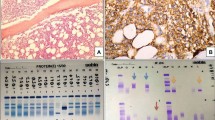Abstract
Paroxysmal nocturnal hemoglobinuria (PNH) is an acquired clonal disorder characterized by a decrease or absence of gly-cosylphosphatidylinositol (GPI)-anchored molecules such as CD55 and CD59 from the surface of affected cells, resulting in intravascular hemolysis, cytopenia, and venous thrombosis. A PNH-like phenotype has been detected in various hematologi-cal disorders, mainly in aplastic anemia and myelodysplastic syndromes, but also in lymphoproliferative syndromes (LPSs).To the best of our knowledge, CD55- or CD59-deficient red cells have not been detected in plasma cell dyscrasias (PCDs). The aim of this study was the detection of CD55- and/or CD59-deficient red cell populations in patients with PCD. Seventy-seven patients were evaluated; 62 with multiple myeloma (MM), 7 with Waldenström macroglobulinemia (WM), 6 with monoclonal gammopathy of undetermined significance (MGUS), and 2 with heavy chain disease (HCD). The sephacryl gel microtyping system was applied; Ham and sucrose lysis tests were also performed on all samples with CD55- or CD59-negative populations. Red cells deficient in both molecules were detected in 10 (12.9%) of 77 patients with PCD: 2 (28.6%) of 7 with WM, 1 (16.6%) of 6 with MGUS, 6 (9.6%) of 62 with MM, and 1 of 2 patients with HCD. Isolated CD55 deficiency was found in 28.5% of all PCD patients, whereas isolated CD59 deficiency was not observed in any patients.These findings illustrate the existence of the PNH phenotype in the red cells of patients with PCD; further investigation is needed into the mechanisms and significance of this phenotype.
Similar content being viewed by others
References
Rotoli B, Luzzatto L. Paroxysmal nocturnal hemoglobinuria.Semin Hematol. 1989;26:201–207.
Luzzatto L, Bessler M. The dual pathogenesis of paroxysmal nocturnal hemoglobinuria.Curr Opin Hematol. 1996;3:101–110.
Rosti V. The molecular basis of paroxysmal nocturnal hemoglobin- uria.Haematologica. 2000;85:82–87.
Rosse WF, Ware R. The molecular basis of paroxysmal nocturnal hemoglobinuria.Blood. 1995;86:3277–3286.
Murakami Y, Kinoshita T, Maeda Y, Nakano T, Kosaka H, Takeda J. Different roles of glycosylphosphatidylinositol in various hematopoietic cells as revealed by a mouse model of paroxysmal nocturnal hemoglobinuria.Blood. 1999;94:2963–2970.
Griscelli-Bennaceur A, Gluckman E, Scrobohaci ML, et al. Aplastic anemia and paroxysmal nocturnal hemoglobinuria: search for a pathogenetic link.Blood. 1995;85:1354–1363.
Dunn DE, Tanawattanacharoen P, Boccuni P, et al. Paroxysmal nocturnal hemoglobinuria cells in patients with bone marrow failure syndromes.Ann Intern Med. 1999;131:401–408.
Meletis J, Terpos E, Samarkos M, et al. Detection of CD55 and/or CD59 deficient red cell populations in patients with aplastic anaemia, myelodysplastic syndromes and myeloproliferative disorders.Haematologica (Budap). 2001;31:7–16.
Guc D, Canpinar H, Kucukaksu C, Kansu E. Expression of complement regulatory proteins CR1, DAF, MCP and CD59 in haema- tological malignancies.Eur J Haematol. 2000;64:3–9.
Hertenstein B, Wagner B, Bunjes D, et al. Emergence of CD52-, phosphatidylinositolglycan-anchor-deficient T lymphocytes after in vivo application of Campath-1H for refractory B-cell non-Hodgkin lymphoma.Blood. 1995;86:1487–1492.
Meletis J, Terpos E, Samarkos M, et al. Detection of CD55 and/or CD59 deficient red cell populations in patients with lymphoprolif- erative syndromes.Hematol J. 2001;2:33–37.
Meletis J, Terpos E. Paroxysmal nocturnal haemoglobinuria: clinical presentation and association with other haematological disorders.Haema. 2001;4:79–88.
Nilsson BO, Hagstrom U, Englund A, Safwenberg J. A simplified assay for the specific diagnosis of paroxysmal nocturnal hemoglo- binuria: detection of DAF (CD55)- and HRF20 (CD59)- erythro- cytes in microtyping cards.Vox Sang. 1993;64:43–46.
Meletis J, Michali E, Samarkos M, et al. Detection of “PNH red cell” populations in hematological disorders using the Sephacryl Gel Test micro typing system.Leuk Lymphoma. 1997;28:177–182.
Fukuda H, Seya T, Hara T, Matsumoto M, Kinoshita T, Masaoka T. Deficiency of complement decay-accelerating factor (DAF, CD55) in non-Hodgkin’s lymphoma.Immunol Lett. 1991;29:205–209.
Seya T, Matsumoto M, Hara T, Hatanaka M, Masaoka T, Akedo H. Distribution of C3-step regulatory proteins of the complement system, CD35 (CR1), CD46 (CMP) and CD55 (DAF) in hematologi- cal malignancies.Leuk Lymphoma. 1994;12:395–400.
Sun X, Funk CD, Deng C, Sahu A, Lambris JD, Song WC. Role of decay-accelerating factor in regulating complement activation on the erythrocyte surface as revealed by gene targeting.Proc Natl Acad Sci U S A. 1999;96:628–633.
Hillmen P, Richards SJ. Implications of recent insights into the pathophysiology of paroxysmal nocturnal haemoglobinuria.Br J Haematol. 2000;108:470–479.
Taylor VC, Sims M, Brett S, Field MC. Antibody selection against CD52 produces a paroxysmal nocturnal hemoglobinuria pheno- type in human lymphocytes by a novel mechanism.Biochem J. 1997;322:919–925.
Rawstron AC, Rollinson SJ, Richards S, et al. The PNH phenotype cells that emerge in most patients after CAMPATH-1H therapy are present prior to treatment.Br J Haematol. 1999;107:148–153.
Araten D, Nafa K, Pakdeesuwan K, Luzzatto L. Clonal populations of hematopoietic cells with paroxysmal nocturnal hemoglobinuria genotype and phenotype are present in normal individuals.Proc Natl Acad Sci U S A. 1999;96:5209–5214.
Kwong YL, Lee CP, Chan TK, Chan TC. Flow cytometric measurement of glycosylphosphatidyl-inositol-linked surface proteins on blood cells of patients with paroxysmal nocturnal hemoglobinuria.Am J Clin Pathol. 1994;102:30–35.
Tremml G, Karadimitris A, Luzzatto L. Paroxysmal nocturnal hemoglobinuria: learning about PNH cells from patients and mice.Haema. 1998;1:12–20.
Author information
Authors and Affiliations
Corresponding author
About this article
Cite this article
Meletis, J., Terpos, E., Samarkos, M. et al. Detection of CD55- and/or CD59-Deficient Red Cell Populations in Patients With Plasma Cell Dyscrasias. Int J Hematol 75, 40–44 (2002). https://doi.org/10.1007/BF02981977
Received:
Revised:
Accepted:
Published:
Issue Date:
DOI: https://doi.org/10.1007/BF02981977




